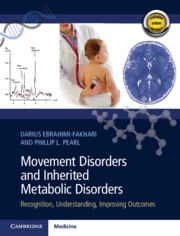Book contents
- Movement Disorders and Inherited Metabolic Disorders
- Movement Disorders and Inherited Metabolic Disorders
- Copyright page
- Dedication
- Contents
- Contributors
- Preface
- Acknowledgments
- Section I General Principles and a Phenomenology-Based Approach to Movement Disorders and Inherited Metabolic Disorders
- Section II A Metabolism-Based Approach to Movement Disorders and Inherited Metabolic Disorders
- Section III Conclusions and Future Directions
- Chapter 30 Metabolic Movement Disorders in the Era of Next-Generation Sequencing
- Chapter 31 Deep Brain Stimulation for Metabolic Movement Disorders
- Chapter 32 Novel Therapeutic Approaches to Metabolic Movement Disorders
- Closing Remarks: A Clinical Approach to Inherited Metabolic Movement Disorders
- Appendix: Video Captions
- Index
- References
Chapter 31 - Deep Brain Stimulation for Metabolic Movement Disorders
from Section III - Conclusions and Future Directions
Published online by Cambridge University Press: 24 September 2020
- Movement Disorders and Inherited Metabolic Disorders
- Movement Disorders and Inherited Metabolic Disorders
- Copyright page
- Dedication
- Contents
- Contributors
- Preface
- Acknowledgments
- Section I General Principles and a Phenomenology-Based Approach to Movement Disorders and Inherited Metabolic Disorders
- Section II A Metabolism-Based Approach to Movement Disorders and Inherited Metabolic Disorders
- Section III Conclusions and Future Directions
- Chapter 30 Metabolic Movement Disorders in the Era of Next-Generation Sequencing
- Chapter 31 Deep Brain Stimulation for Metabolic Movement Disorders
- Chapter 32 Novel Therapeutic Approaches to Metabolic Movement Disorders
- Closing Remarks: A Clinical Approach to Inherited Metabolic Movement Disorders
- Appendix: Video Captions
- Index
- References
Summary
As pharmacological management is dissatisfying in many metabolic movement disorders, neurosurgical procedures have been attempted to alleviate the most disabling symptoms, which are often severe dystonia, chorea, tremor, and self-mutilating behavior. These neurosurgical procedures include ablative procedures and deep brain stimulation (DBS), typically targeting the basal ganglia.
- Type
- Chapter
- Information
- Movement Disorders and Inherited Metabolic DisordersRecognition, Understanding, Improving Outcomes, pp. 375 - 392Publisher: Cambridge University PressPrint publication year: 2020



